History > AS Mark Scheme > GCE History A Y315/01: The changing nature of warfare 1792-1945 Advanced GCE Mark Scheme for Novembe (All)
GCE History A Y315/01: The changing nature of warfare 1792-1945 Advanced GCE Mark Scheme for November 2020
Document Content and Description Below
Oxford Cambridge and RSA Examinations GCE History A Y315/01: The changing nature of warfare 1792-1945 Advanced GCE Mark Scheme for November 2020Oxford Cambridge and RSA Examinations OCR (Oxford ... Cambridge and RSA) is a leading UK awarding body, providing a wide range of qualifications to meet the needs of candidates of all ages and abilities. OCR qualifications include AS/A Levels, Diplomas, GCSEs, Cambridge Nationals, Cambridge Technicals, Functional Skills, Key Skills, Entry Level qualifications, NVQs and vocational qualifications in areas such as IT, business, languages, teaching/training, administration and secretarial skills. It is also responsible for developing new specifications to meet national requirements and the needs of students and teachers. OCR is a not-for-profit organisation; any surplus made is invested back into the establishment to help towards the development of qualifications and support, which keep pace with the changing needs of today’s society. This mark scheme is published as an aid to teachers and students, to indicate the requirements of the examination. It shows the basis on which marks were awarded by examiners. It does not indicate the details of the discussions which took place at an examiners’ meeting before marking commenced. All examiners are instructed that alternative correct answers and unexpected approaches in candidates’ scripts must be given marks that fairly reflect the relevant knowledge and skills demonstrated. Mark schemes should be read in conjunction with the published question papers and the report on the examination. © OCR 2020Y315/01 Mark Scheme November 2020 2 Annotations Annotation Meaning of annotation Blank Page Highlight Off-page comment Assertion Analysis Evaluation Explanation Factor Illustrates/Describes Irrelevant, a significant amount of material that does not answer the question Judgement Knowledge and understanding Provenance Simple comment Unclear View Synthesis Continuity/ChangeY315/01 Mark Scheme November 2020 3 Subject Specific Marking Instructions Section A Question Answer Mark Guidance 1 Evaluate the interpretations in both of the two passages and explain which you think is more convincing as an explanation of the impact of technological developments on the First World War. • In locating the Interpretations within the wider historical debate, answer might argue that Interpretation A puts forward the view that that the impact of technological developments was limited. • In evaluating Interpretation A, answers might argue that Interpretation A is valid as early tanks were unreliable and the armour-plating vulnerable to artillery. • Answers might argue that Interpretation A is valid as the command structure and use of stromtroopers provided flexibility which allowed advance in early 1918. • Answers might argue that Interpretation A is not valid as it ignores the success of technological developments, such as chemical weapons in 1918. • Answers might argue that Interpretation A is valid is many of the breakthroughs made in the later stages of the war were due to changes in leadership and tactics. • In locating the Interpretations within the wider historical debate, answers might argue that Interpretation B puts forward the view that 30 • No set answer is expected • At Level 5 and above answers will evaluate both interpretations, locating them within the wider historical debate about the issue and using their own knowledge, and reach a balanced judgement as to which they consider the most convincing about the issue in the question. • To be valid, judgements must be supported by relevant and accurate material. • Knowledge must not be credited in isolation, it should only be credited where it is used to analyse and evaluate the interpretations, in line with descriptions in the levels mark schemeY315/01 Mark Scheme November 2020 4 2* technological developments had an important impact on the war, particularly in its latter stages. • In evaluating Interpretation B, answers might argue it is valid as there was more effective use of artillery after the Somme. • Answers might argue that Interpretation B is valid as 378 tanks were used successfully at Cambrai, providing greater protection against machine guns and mobility. • Answers might argue that Interpretation B is invalid as many tanks broke down at Cambrai, with the British losing 300. • Answers might argue that Interpretation B is valid as the creeping barrage forced the enemy to take cover. • Answers might argue that Interpretation B is valid as tanks were used in conjunction with infantry in 1918 • Answers might argue that Interpretation B is valid as lighter machine guns were developed and that developments in aircraft technology allowed them to play a role in the breakthrough ‘Generalship had a greater impact on the conduct of war than the quality of soldiers.’ How far do you agree with this view of the period from 1792 to 1945? • In arguing that generalship had a greater impact it might be argued that in the First World War generals persisted with traditional methods of fighting until 1917. • Answers might consider the personal leadership of Napoleon, his organisation, grand tactics and trust in him which motivated soldiers. • Answers might consider the importance of Lee in the American Civil War, which enabled the 25 • No set answer is expected • At higher levels answers might establish criteria against which to judge • To be valid, judgements must be supported by relevant and accurate material. • Knowledge must not be credited in isolation, it should only be credited where it is used as the basis for analysis and evaluation, in line with descriptions in the levels mark scheme.Y315/01 Mark Scheme November 2020 5 South to be defended and even go on the offensive. • Answers might consider the strategic imagination of Grant, capturing rail junctions and using gunboats to split the south. • Answers might consider the weak leadership in the Crimean War. • Answers might consider the use of mobile tactics by Boer commanders. • Answers might consider the use of stormtroopers by Ludendorff in 1918 to achieve a breakthrough. • Answers might consider how the nature of generalship changed so that at the end they became managers and had less impact on the nature of war. • In arguing that the quality of soldiers was more important, it might be argued that in the Revolutionary wars the lack of a well-trained force which led to the frontal assault with heavy casualties. • Answers might consider that generalship became less important as the size of forces increased. • Answers might consider that national enthusiasm was important, as seen in Sicily and southern Italy. • Answers might consider the use of mass volunteer armies in the American Civil War. • Answers might consider the use of large armies in the First World War as ‘battering rams’. • Answers might consider the professionalism of the German army in the First World War which allowed non-commissioned officers to take on leadership of small groups, continued in the Second World War.Y315/01 Mark Scheme November 2020 6 3* • Answers might consider the use of guerilla warfare where local forces or irregulars with little training were used, • Answers might consider that mass citizen armies could not perform complex manoeuvres. • Answers might consider that increased education allowed soldiers to quickly acquire new skills at the end of the period. ‘Alliances had a more significant impact on the outcome of wars in the period before 1865 than after.’ How far do you agree with this view of warfare in the period from 1792 to 1945? • In supporting the view that alliances were more significant before 1865, it might be argued that the defeat of Napoleon was due to the coalition becoming an alliance. • Answers might consider the importance of the alliance of Britain, France, Turkey and Austria in securing victory in the Crimean War. • Answers might consider the failure of the Confederacy to secure allies which led to its defeat in the American Civil War. • Answers might consider that the alliance of France and Piedmont allowed the removal of Austria from parts of Italy. • Answers might consider that alliances were important in the early period but economic resources became more important in the twentieth century, • In challenging the view that alliances were more significant before 1865, it might be argued that the failure of alliances allowed Napoleon to dominate Europe until 1812. 25 • No set answer is expected • At higher levels answers might establish criteria against which to judge • To be valid, judgements must be supported by relevant and accurate material. • Knowledge must not be credited in isolation, it should only be credited where it is used as the basis for analysis and evaluation, in line with descriptions in the levels mark scheme.Y315/01 Mark Scheme November 2020 7 4* • Answers might consider the impact of the USA joining the Allied powers in both 1917 and 1941. • Answers might consider that it was the weakness of Russia in the Crimean War that led to their defeat. • Answers might consider that it was the superior resources of the North that led to victory in the American Civil War. • Answers might consider that Bismarck isolation of Austria and France helped secure victory in the wars of 1866 and 1870. • Answers might consider that alliances in 1914 drew nations into the war and made it last longer. • Answers might consider alliances weakened Germany as it had to go to the aid of Italy. ‘Domestic factors played little part in the outcome of wars throughout the period from 1792 to 1945.’ How far do you agree? • In supporting the argument domestic factors played little part, that until the development of total war there was little domestic involvement. • Answers might consider that public opinion had little impact on the outcome of wars. • Answers might consider that propaganda had little impact on the outcome, as seen in Germany in World War II. • Answers might consider the importance of technology in deciding the outcome of wars. • Answers might consider the impact of alliances in deciding the outcome of wars. 25 • No set answer is expected • At higher levels answers might establish criteria against which to judge • To be valid, judgements must be supported by relevant and accurate material. • Knowledge must not be credited in isolation, it should only be credited where it is used as the basis for analysis and evaluation, in line with descriptions in the levels mark scheme.Y315/01 Mark Scheme November 2020 8 • Answers might consider the planning and preparation in deciding the outcome. • Answers might consider the role of generalship and soldiers in deciding the outcome. • In challenging the view that domestic factors played little part, it might be argued that states created nationalism which inspired soldiers as in France and Italy. • Answers might consider that with total war state involvement was crucial and there was a need to maintain morale. • Answers might consider that the state needed to ensure production for the military, as with shell shortages. • Answers might consider how domestic unrest impacted Russia and Germany in 1917 and 1918. • Answers might consider how civilian commitment was crucial when France was fighting for survival in the 1790s. • Answers might consider the importance of the organisation of the state with recruitment, procurement and delivery of supplies.Y315/01 Mark Scheme November 2020 9 APPENDIX 1 – this contains a generic mark scheme grid AO3: Analyse and evaluate, in relation to the historical context, different ways in which aspects of the past have been interpreted. Generic mark scheme for Section A, Question 1: Interpretation [30] Level 6 26–30 marks The answer has a very good focus on the question throughout. It has thorough and sustained evaluation of the interpretations, using detailed and accurate knowledge of the historical context and the wider historical debate around the issue, in order to produce a convincing and supported analysis of them in relation to the question. Level 5 21–25 marks The answer has a good focus on the question throughout. It has good evaluation of the interpretations, using relevant knowledge of the historical context and the wider historical debate around the issue, in order to produce a supported analysis of them in relation to the question. Level 4 16–20 marks The answer is mostly focused on the question. It has evaluation of the interpretations based on generally relevant knowledge of the historical context and the wider historical debate around the issue, in order to produce an analysis of them in relation to the question. Level 3 11–15 marks The answer is partially focused on the question. It has partial evaluation of the interpretations based on some knowledge of the historical context and the wider historical debate around the issue. There may be some use of information from one of the two interpretations to support the evaluation of the other, but the evaluation will not rely on this. There is a limited analysis of the interpretations in relation to the question. Level 2 6–10 marks The answer has a limited focus on the question. Parts of the answer are just description of the interpretations, with evaluation in relation to historical context and the wider historical debate around the issue being weak, and evaluation relying heavily on information drawn from the other interpretation. There is a very limited analysis of the interpretations in relation to the question. Level 1 1–5 marks The answer has some relevance to the topic, but not the specific question. The answer consists mostly of description of the interpretations with very limited evaluation based on very generalised knowledge of historical context and minimal or no reference to the wider historical debate. Analysis of the interpretations in relation to the question is either in the form of assertion or lacking. 0 marks No evidence of understanding and no demonstration of any relevant knowledge.Y315/01 Mark Scheme November 2020 10 AO1: Demonstrate, organise and communicate knowledge and understanding to analyse and evaluate the key features related to the periods studied, making substantiated judgements and exploring concepts, as relevant, of cause, consequence, change, continuity, similarity, difference and significance. Generic mark scheme for Section B, Questions 2, 3 and 4: Essay [25] Level 6 21–25 marks The answer has a very good focus on the question. Detailed and accurate knowledge and understanding is used to analyse and evaluate key features of the period studied in order to reach a fully developed synthesis supporting a convincing and substantiated judgement. There is a well-developed and sustained line of reasoning which is coherent and logically structured. The information presented is entirely relevant and substantiated. Level 5 17–20 marks The answer has a good focus on the question. Generally accurate and detailed knowledge and understanding is used to analyse and evaluate key features of the period studied in order to reach a developed synthesis supporting a substantiated judgement. There is a well-developed line of reasoning which is clear and logically structured. The information presented is relevant and in the most part substantiated. Level 4 13–16 marks The answer is mostly focused on the question. Relevant knowledge and understanding is used to analyse and evaluate key features of the period studied in order to reach a synthesis supporting a reasonable judgement. There is a line of reasoning presented with some structure. The information presented is in the most-part relevant and supported by some evidence. Level 3 9–12 marks The answer has a partial focus on the question. Some relevant knowledge and understanding is used to analyse and explain key features of the period studied in order to attempt an undeveloped synthesis, which is linked to a judgement, though the supporting explanation may lack detail and clarity. The information has some relevance and is presented with limited structure. The information is supported by limited evidence. Level 2 5–8 marks The answer has only a limited focus on the question. Limited relevant knowledge and understanding is used to give a limited explanation and analysis of key features of the period studied. There is a judgement but this may not be clearly linked with the supporting explanation. The information has some relevance, but is communicated in an unstructured way. The information is supported by limited evidence and the relationship to the evidence may not be clear. Level 1 1–4 marks The answer has a limited focus on the topic, but not the specific question. The answer is largely descriptive, with only very generalised knowledge of the period studied being used to attempt basic explanation and very limited analysis. Judgements are unsupported and are not linked to analysis. Information presented is basic and may be ambiguous or unstructured. The information is supported by limited evidence. 0 marks The answer contains no relevant information.Y315/01 Mark Scheme November 2020 11 APPENDIX 2 – this section contains additional subject specific information Use this space if you have extensive subject specific information that is inappropriate to include elsewhere.OCR (Oxford Cambridge and RSA Examinations) The Triangle Building Shaftesbury Road Cambridge CB2 8EA [Show More]
Last updated: 1 year ago
Preview 1 out of 13 pages
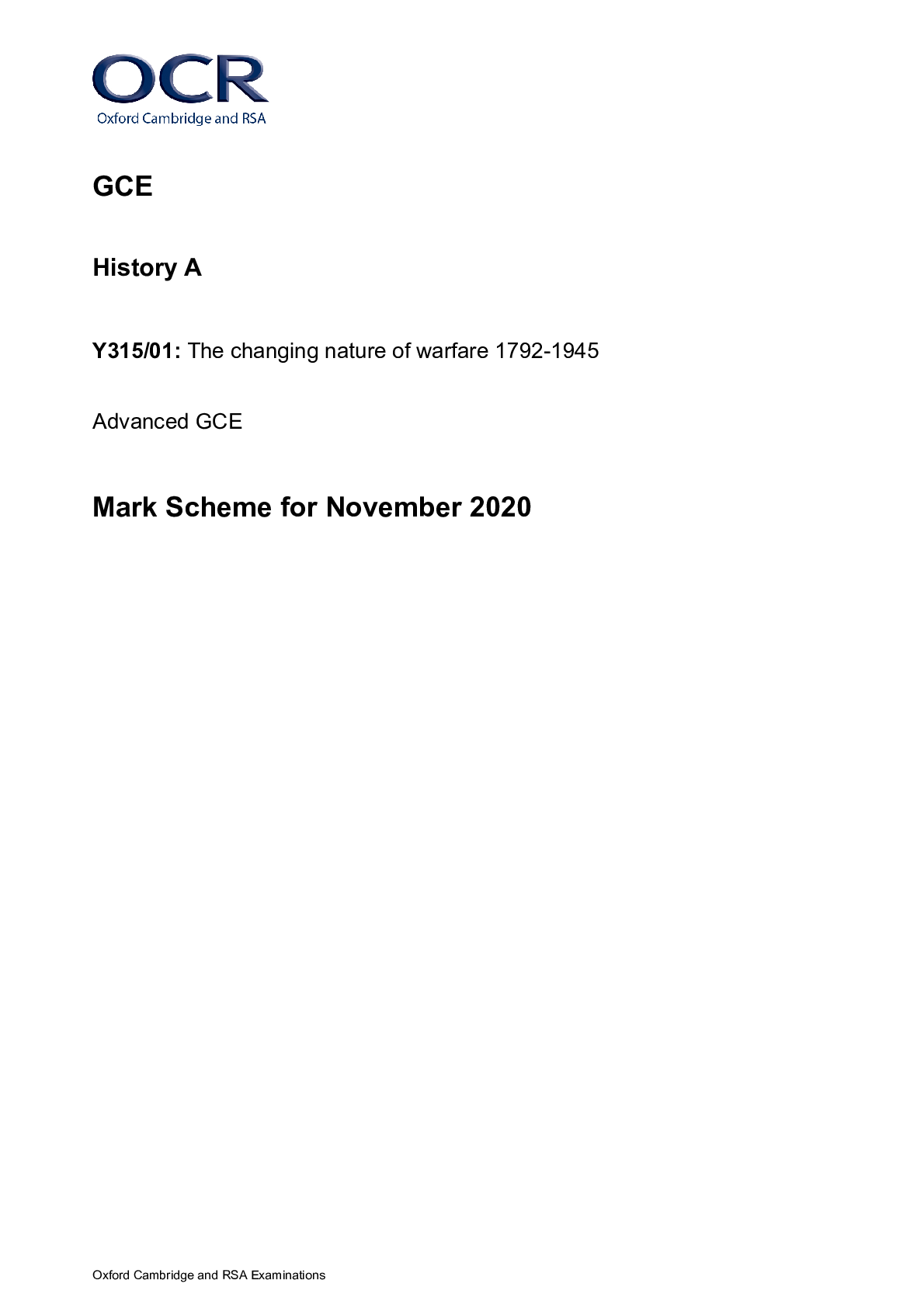
Reviews( 0 )
Document information
Connected school, study & course
About the document
Uploaded On
Oct 10, 2022
Number of pages
13
Written in
Additional information
This document has been written for:
Uploaded
Oct 10, 2022
Downloads
0
Views
66








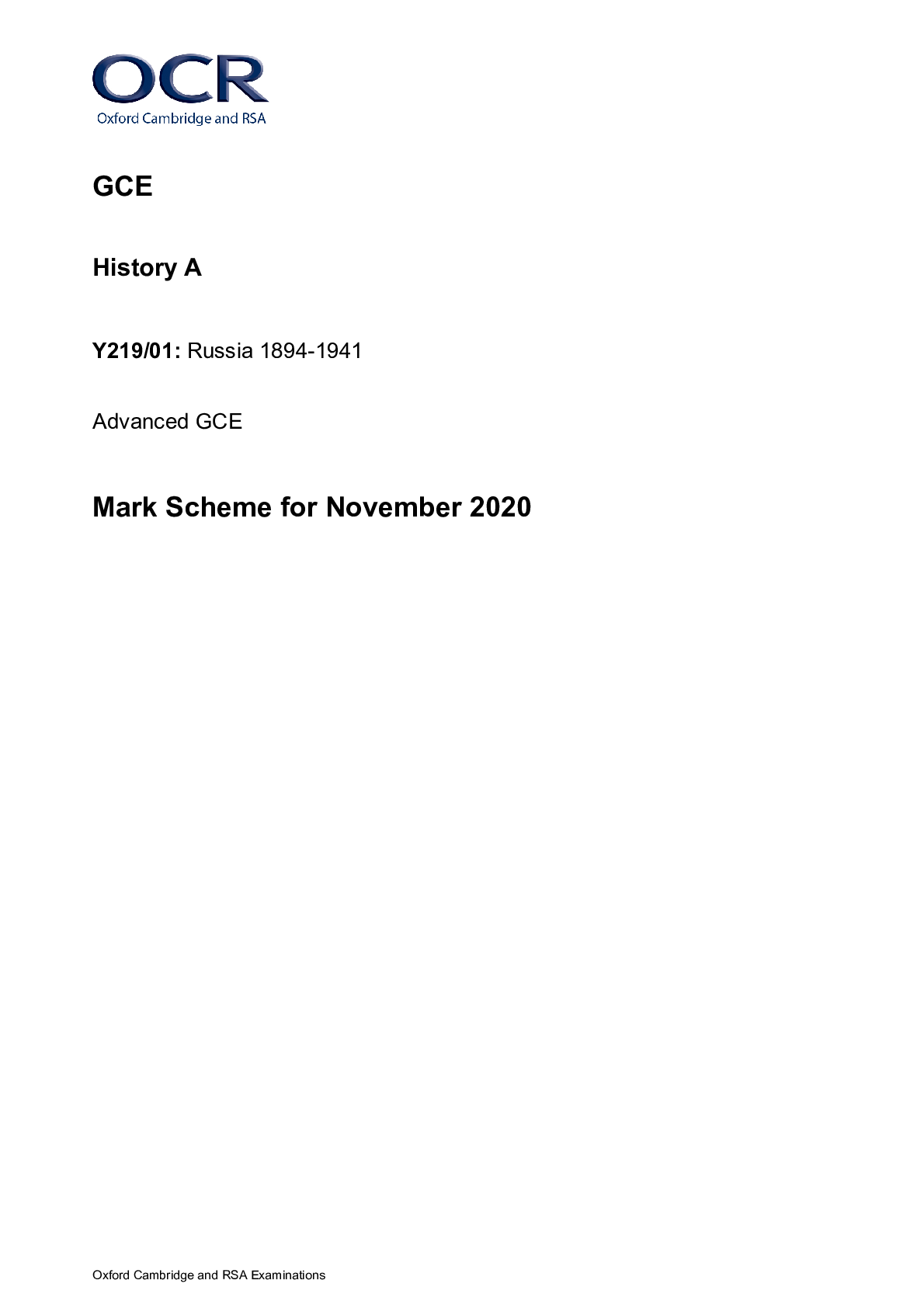
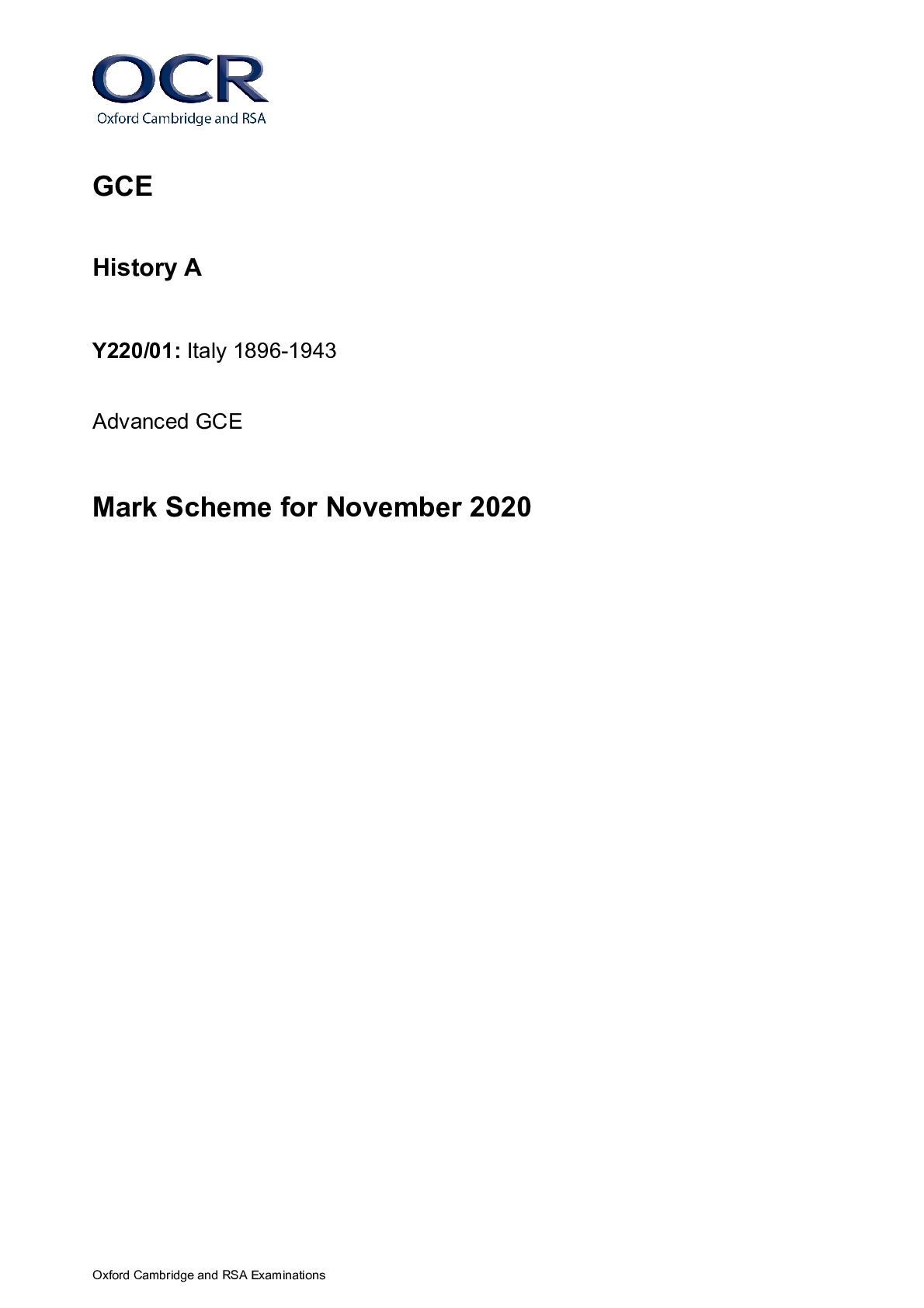

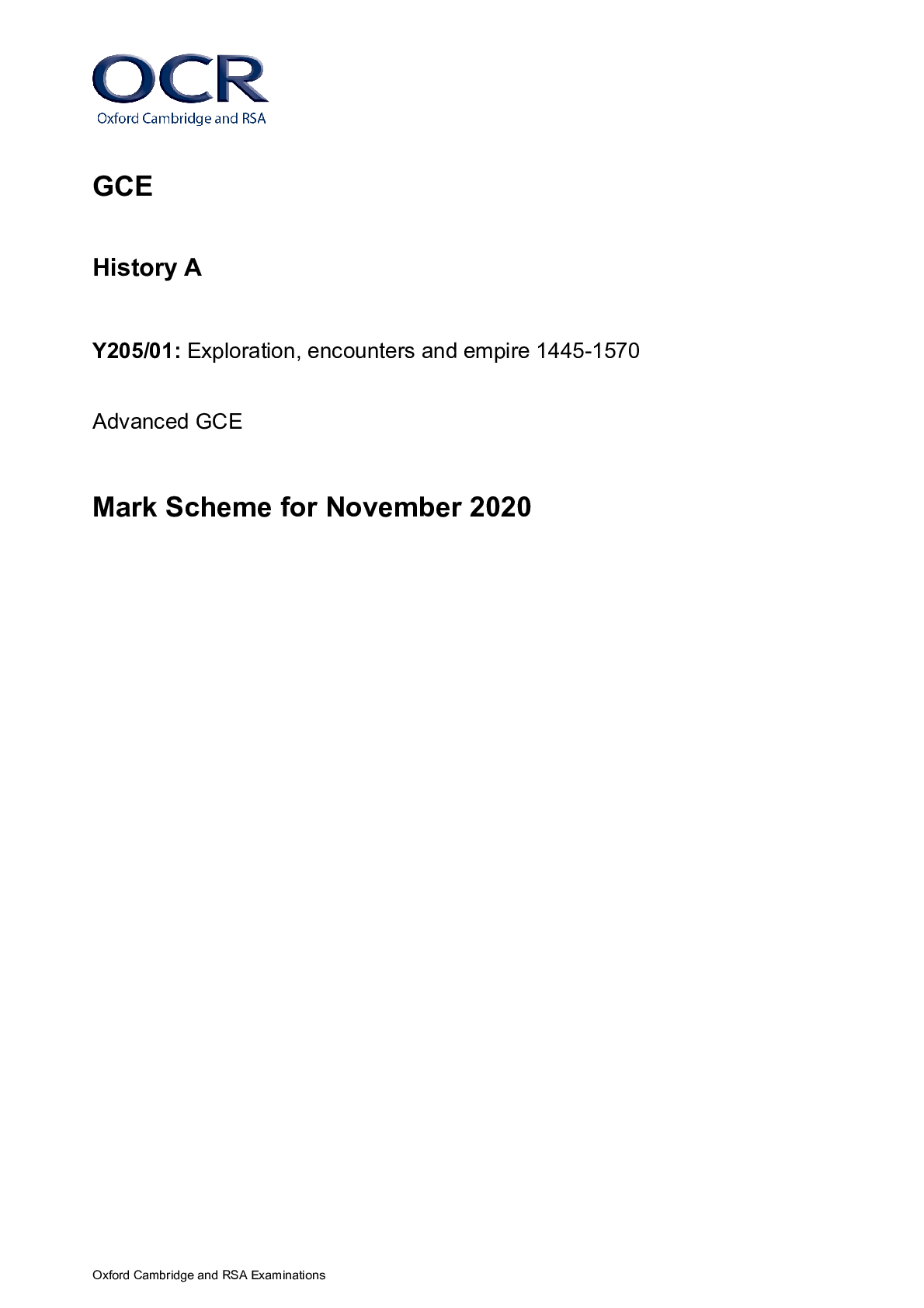
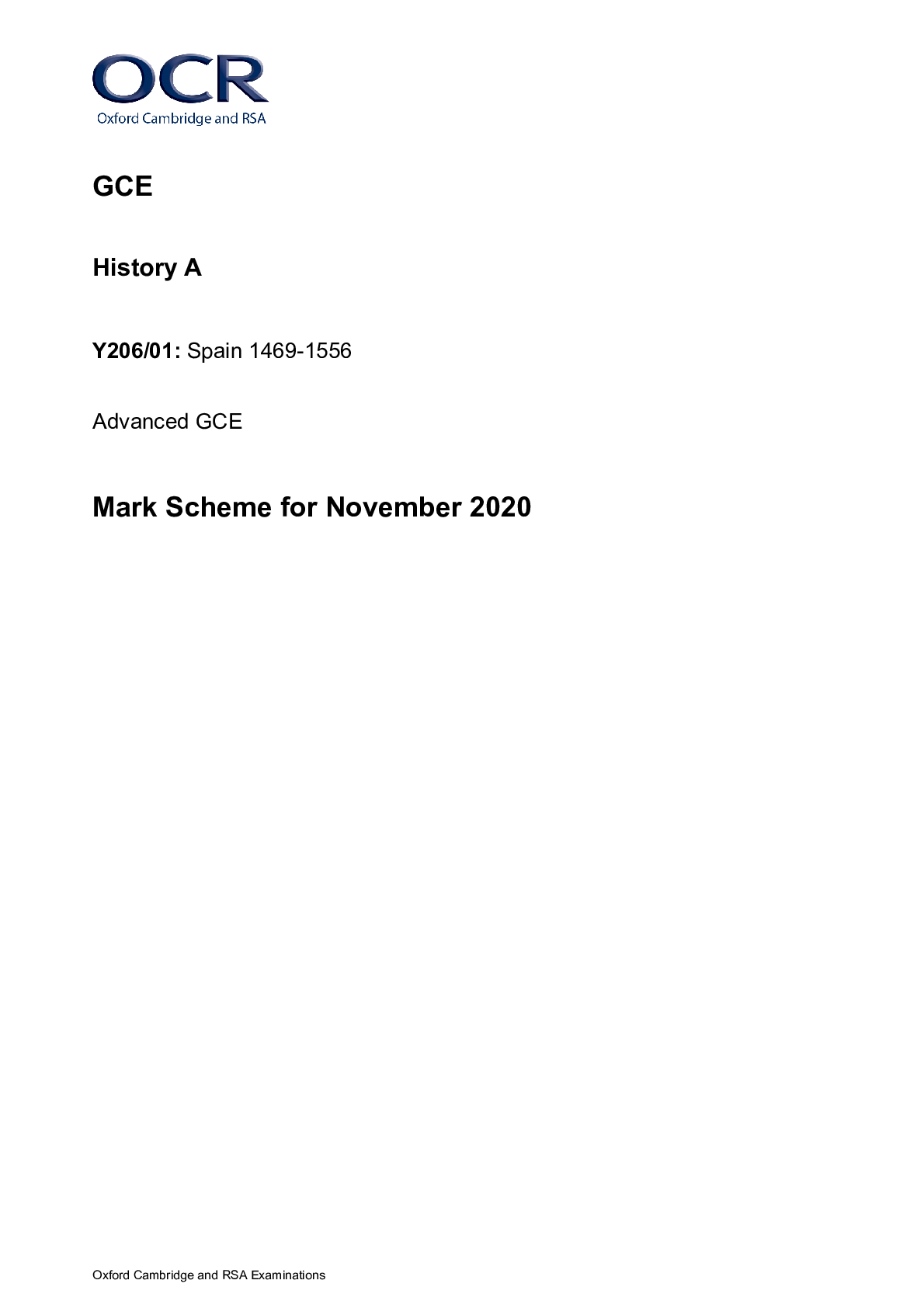
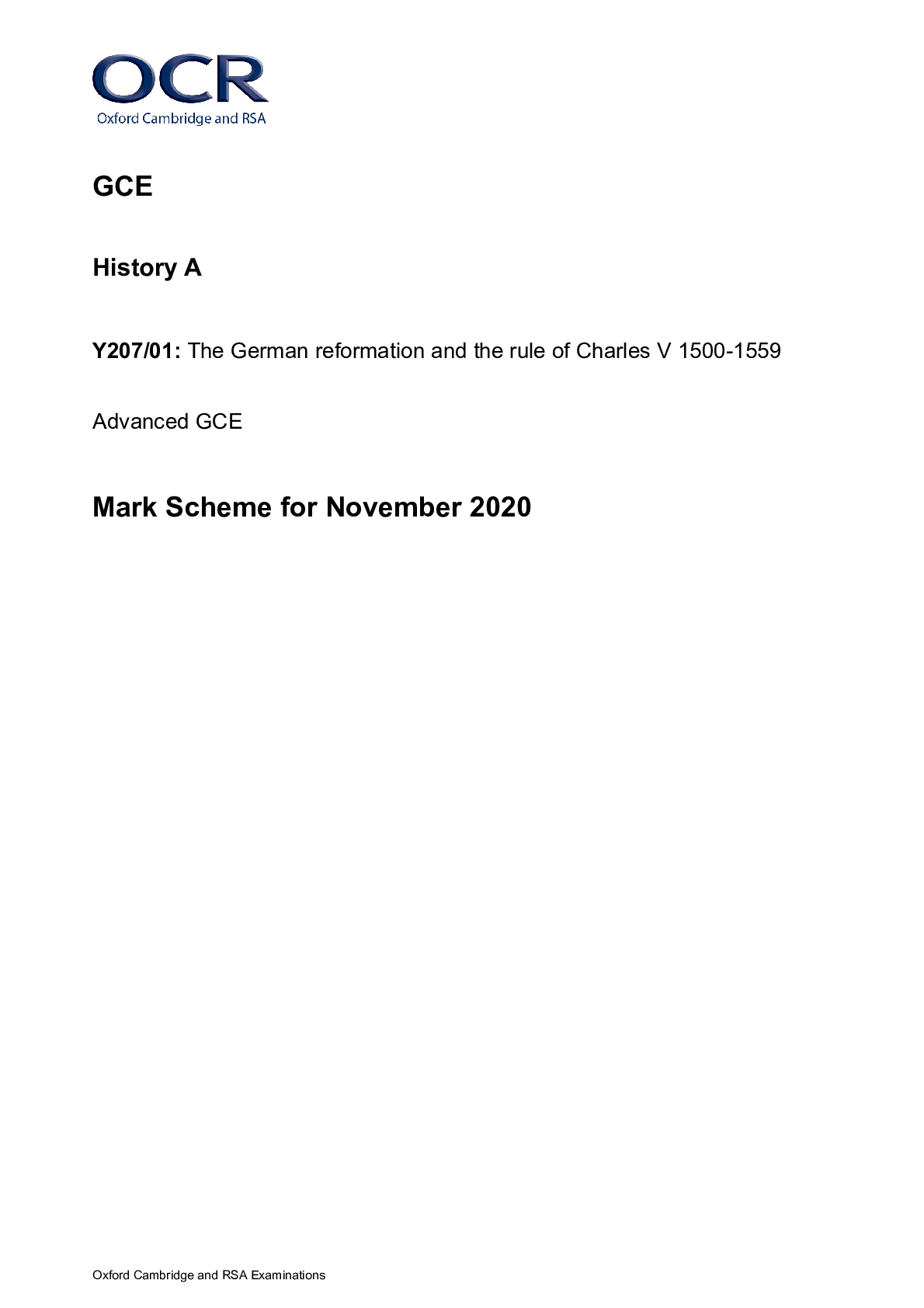
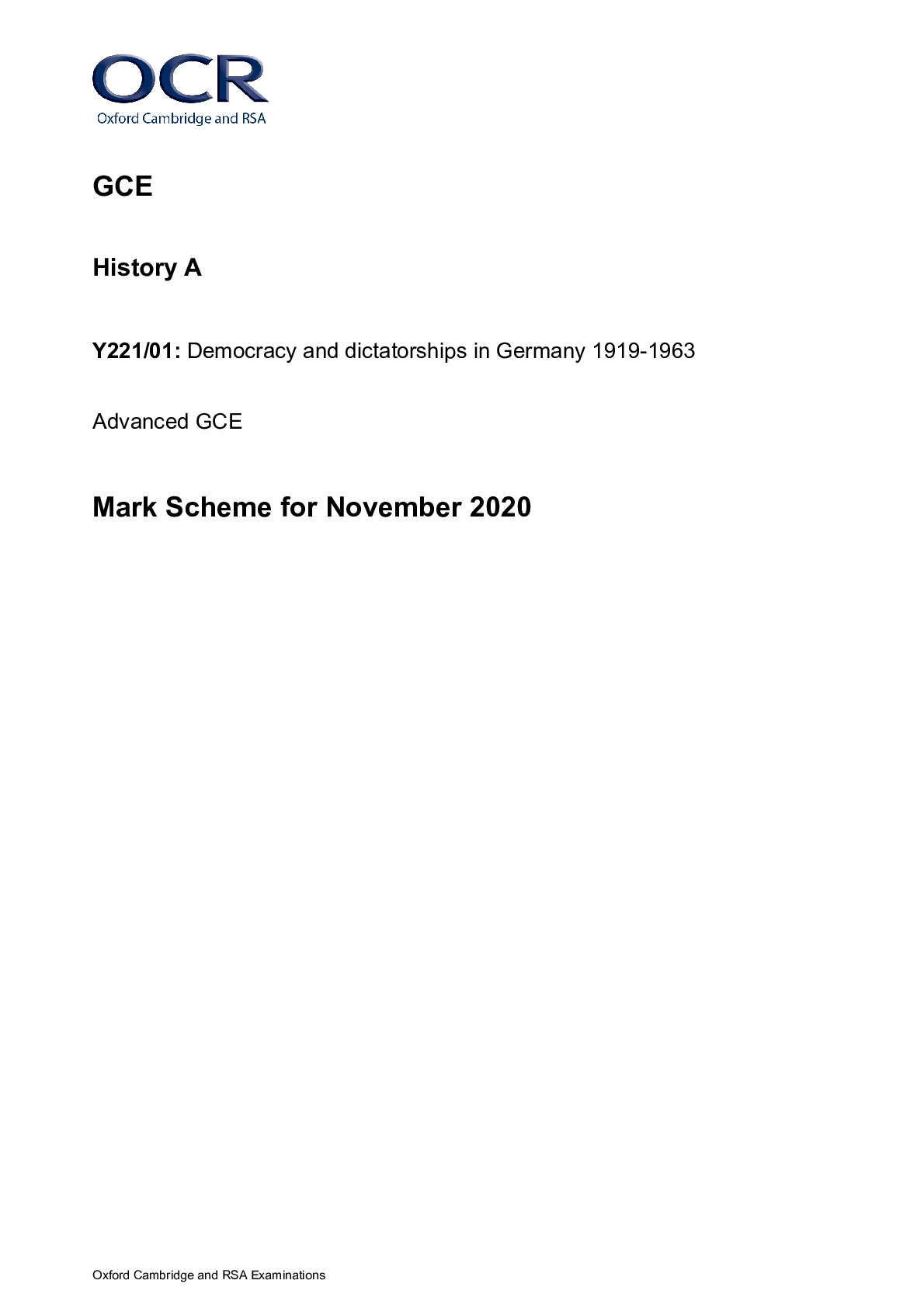

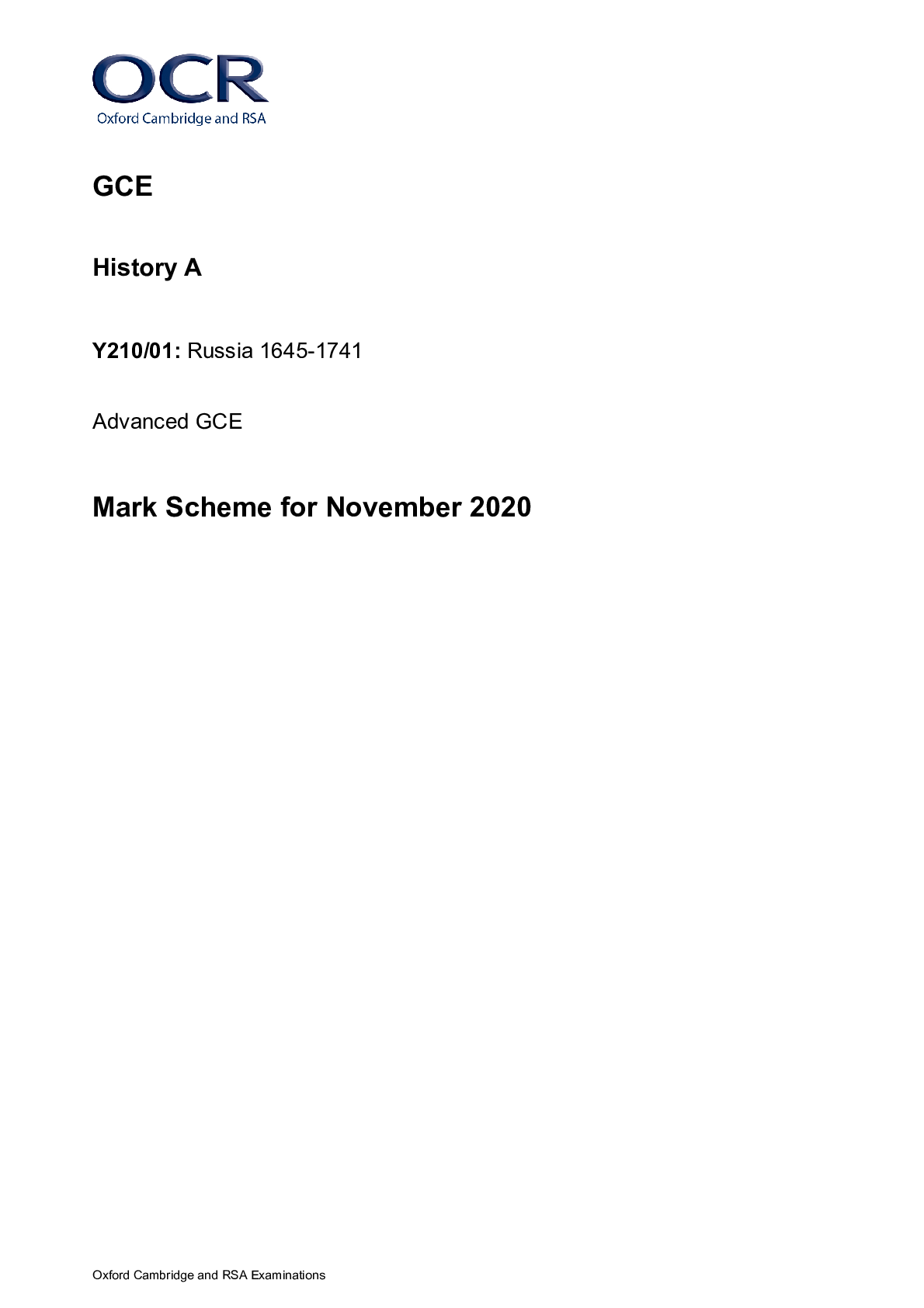


.png)






